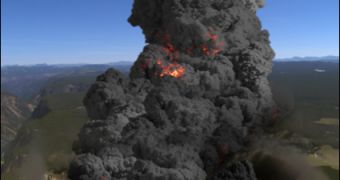We have recently written about an event that nearly extinguished all life on Earth some 250 million years ago. It had to do with the most massive superplume ever that originated in the near-core region of the Earth and slowly reached towards the surface during millions of years, culminating with three large volcanic explosions; the third, the Siberian Straps, obliterated some 90% of the world's species. Supervolcanoes. There has been quite a hefty amount of such events throughout history and there's no reason why they couldn't happen again at any time.
A supervolcano is, by definition, significantly larger in terms of eruption than a regular volcano (more than 200 cubic km), as well as in terms of its effect on the environment. This kind of phenomenon can determine weather-affecting changes that could, in turn, trigger long-lasting climate perturbations, such as ice ages. Also, they cover enormous surfaces with ash and lava. All these can lead to a major negative impact on the environment and, subsequently, to all life forms that may depend on it, and their eruptions most often form calderas instead of cones.
The Siberian Straps was not the largest of the eruptions if we take into consideration the ejected material. It “only” yielded about 2000 km3 of material, but the Fish Canyon Tuff, occurring some 27.8 million years ago in the region of La Garita Caldera, Colorado, United States, brought up around 5,000 km3 of ejecta.
The most recent super-eruption with a Volcanic Explosivity Index of 8 (VEI 8, over 1,000 cubic meters) was the Oruanui eruption (1,170 km3), which occurred 26,500 years ago in Lake Taupo, New Zealand, providing a caldera, now flooded, which offers one of the world's most beautiful landscapes.
Other important events of this kind occurred in Lake Toba, Sumatra, Indonesia, about 75,000 years ago (2,800 km3), Island Park Caldera, Idaho/Wyoming, United States, 2.1 million years ago (2,500 km3), Kilgore Tuff, Idaho, United States, 4.5 million years ago (1,800 km3), Black Tail Creek, Idaho, United States, 6.6 millions years ago (1,500 km3), and at the Yellowstone Caldera, Wyoming, United States, 640,000 years ago (1,000 km3).
Some of the supervolcanoes have showed signs of activity or even reduced eruption in more recent times. Usually, the more worrying signs occur long before the eruption, so measures can be taken. The fact that the largest eruptions happened so long ago only leaves geologists with two options: studying the remains of ancient explosions or turn to astronomers for similar data collected from alien worlds where similar events still take place, such as Jupiter's Io moon.
Among many others, a Jovian Connecticut-sized volcano with a 200-km (125-mi) wide crater has a lava expanse as wide as Lake Michigan. "That one volcano is putting out as much heat as the entire planet Earth," shared planetary astronomer John Spencer from the Southwest Research Institute, cited by Discovery.

 14 DAY TRIAL //
14 DAY TRIAL //